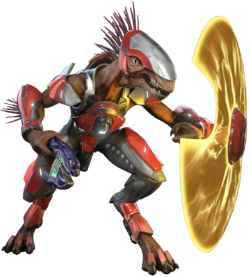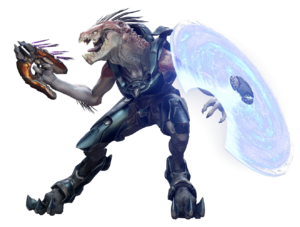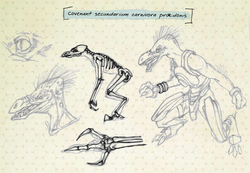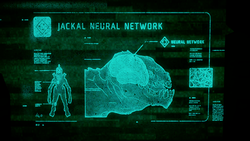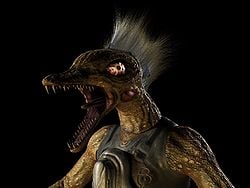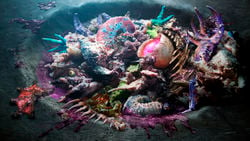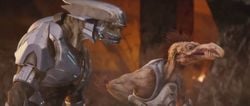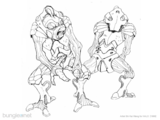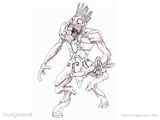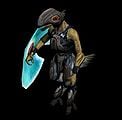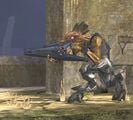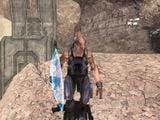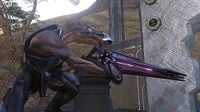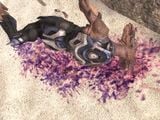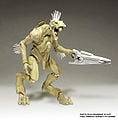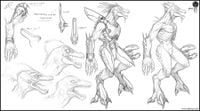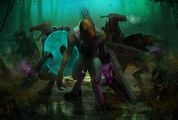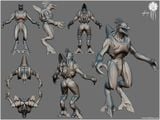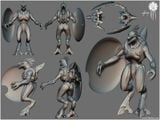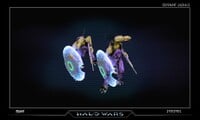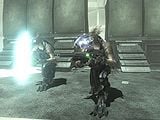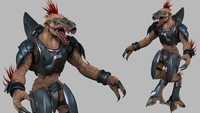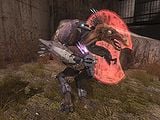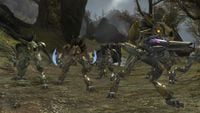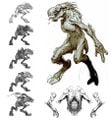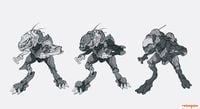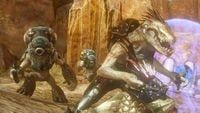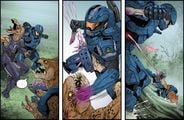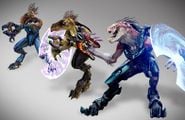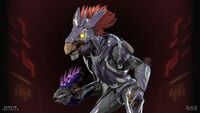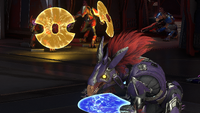Kig-Yar
From Halopedia, the Halo wiki
| Kig-Yar | |
|---|---|
| Biological overview | |
|
Latin name: |
Perosus latrunculus [1] |
|
Classification: |
Saurian[1] |
|
Subspecies: |
|
|
Diet: |
Omnivorous[2] |
| Physical information | |
|
Avg. height: |
190–210 cm (6 ft 2 in–6 ft 8 due to hunched over anatomy they appear shorter about 5ft or 155 cm)[3] |
|
Avg. weight: |
88–93 kilograms (195–206 lbs)[3] |
|
Distinctions: |
Sinewy and slender; dinosauroid features, tridactyl clawed hands and feet |
| Sociocultural information | |
|
Homeworld: |
|
|
Native Tier 4 (Adopted Tier 2)[4] | |
|
Notable individuals: |
|
|
Also known as: |
|
|
Languages: |
|
- "Jackals may be superior marksmen and they're very sneaky, but that doesn't make them excellent snipers — they’re a little too bloodthirsty for that."
- — Anonymous UNSC Marine
The Kig-Yar (sometimes rendered as "Kig-yar"; Forerunner designation: Perosus latrunculus, Latin for "hateful bandit";[6] UNSC designation: Covenant secundarium carnivora prœdonis, Latin for "Covenant secondary carnivorous combatant"[7]) are a dinosaur-like saurian species.[8] Following their assimilation in 1342 CE, the Kig-Yar served the Covenant until its dissolution in 2552. Many went on to aid its remnants as mercenaries, privateers, and pirates, though the majority stayed independent of any such factions.
There are several distinct races of Kig-Yar, though humans have commonly identified two groupings (Jackals and Skirmishers) based on encounters in the battlefield. In combat, Kig-Yar typically served the Covenant as snipers and scouts due to their excellent senses of sight, smell, and hearing.[9]
History[edit]
The Ark and reseeding[edit]
The Kig-Yar were one of many species indexed by the Librarian as part of the Conservation Measure and preserved on Installation 00 from the firing of the Halo Array. They were subsequently returned to their homeworld, where they began rebuilding their culture.[10]
Development of civilization[edit]
The Kig-Yar are believed to have evolved from a saurian species on the continent of Ah'lomet.[11] During their early history, Kig-Yar society was divided into clans that sailed across Eayn's seas as pirates, raiding the encampments and settlements of rival clans.[12] Ancient Kig-Yar once experienced a gladiatorial era, similar to humans. These ancient Kig-Yar would hold inter-clan physical combat competitions in the largest population centers on Eayn's biggest continent.[13] Excessive raiding and piracy on Eayn would ultimately culminate in the Czaalo Wars - a series of large-scale conflicts.[14] Eventually, the clans united, and the Kig-Yar species worked together in developing space-travel technology.[15]
Shortly afterward, they established colonies on many small asteroids and planetoids around Chu'ot. The Kig-Yar on these asteroids were sustained by gray market trade and developed free from the government that dominated Eayn. Some Kig-Yar continued their ancient ways of life and became pirates once more, preying upon merchant starships. The piracy and looting in the system led to the Kig-Yar government's militia recruiting selectively picked Commandos from sectarian societies from the asteroids that orbit Chu'ot. The Commandos fought off the pirates in an extremely ruthless and precise fashion.[13] When the overwhelming Covenant military juggernaut arrived in the Kig-Yar home system in 1342, the Kig-Yar pirates and militia joined forces in an attempt to fend off the alien intruders.[15]
The Covenant[edit]
At first, the Covenant arrived in the Kig-Yar home system with small contingent fleets. These fleets were directly attacked by ruthless Kig-Yar pirates and mercenaries, leading to a long naval war in the system.[1] Despite the sheer strength and numbers of the Covenant, the Kig-Yar used the Y'Deio system to their advantage. It was difficult for the larger Covenant ships to maneuver through Y'Deio's abnormally dense asteroid belt compared to the Kig-Yar's smaller vessels, while Kig-Yar forces could use the asteroids for hiding.[16] The war between the Covenant and Kig-Yar forces culminated in sieges of redoubts on the asteroids surrounding their world. Eventually, realizing the unlikelihood of them winning the war and the opportunity to profit from the expansion of trade, they accepted Letters of Marque: commissions from the Ministry of Tranquility to engage in the services of the Covenant, though often this was merely used as an excuse to continue their plundering lifestyle. The Kig-Yar would spend much of their time preying on the ships of the Covenant's enemies, such as humanity.[17]
Kig-Yar are around the same level as the Unggoy in the Covenant hierarchy, although the Kig-Yar despised the Unggoy and believed themselves to be superior. This reached a boiling point in 2462, when the growing Unggoy population on High Charity put pressure on the Kig-Yar as many of the Kig-Yar were forced to relocate their homes and nests to accommodate the Unggoy. The relocation caused stress for female Kig-Yar that were going through their incubation cycles, and Kig-Yar infant mortality rose on High Charity and the birth rate declined. To exact their revenge, a radical group of Kig-Yar shipmasters poisoned infusions—recreational narcotics the Unggoy enjoyed—on High Charity and on the vessels operated by the Kig-Yar which left many male Unggoy sterile.[18] Although a junior staffer in the Ministry of Concert found evidence of this, the High Council failed to properly investigate the incident, as they were willing to accept several thousand sterile Unggoy rather than risk upsetting the Kig-Yar. As a result, the offending Kig-Yar were not imprisoned and the guilty shipmasters were simply fined for damages. The lack of attention and the case's results eventually culminated to the Unggoy Rebellion.[19] The Unggoy began to attack, not only the Kig-Yar but, all other races in the Covenant. The Sangheili and Kig-Yar faced difficulty quelling the rebellion, which led to an Arbiter partially glassing Balaho to convince the Unggoy to surrender.[20]
Human-Covenant War[edit]
- Main article: Human-Covenant War
A Kig-Yar missionary ship, the Minor Transgression, was the first Covenant vessel to make contact with humanity.[21] The ship raided a commercial freighter leaving the planet Harvest, and the events that followed would later lead to full-scale military action on the part of humanity and the Covenant.[22] The Kig-Yar serving with the Ministry of Tranquility would continue to patrol the space around humanity's known territory. The Kig-Yar were responsible for discovering numerous human colonies, such as Madrigal, and would report their findings to the rest of the Covenant fleet.[23]
Following the outbreak of the Human-Covenant War, human encounters with Kig-Yar were brief and poorly documented. Rumors and fragmentary evidence pointed to incidents of Jackal piracy against human civilians.[24]
In 2535, a group of Kig-Yar under Reth discovered the Rubble, a community of Insurrectionists and human survivors of the glassing of Madrigal, while attempting to mine the asteroids in the 23 Librae system.[25] Peter Bonifacio, a member of the Rubble Security Council, made contact with the Kig-Yar and agreed to trade Covenant weaponry in exchange for human slipspace drives.[26] Although the humans believed the Kig-Yar were rebels defying Covenant authority, they were in fact secretly proceeding with the blessing of the High Prophet of Truth to use the weapons to map UNSC space and learn the location of Earth and other human colonies.[27] Reth had created an Unggoy army on a nearby moon with the intents to attack the Rubble with it and use it for Kig-Yar nesting grounds. However, the plan fell apart due to the High Prophet of Regret sending Sangheili warriors to investigate the weapons, believing the Kig-Yar to be heretics.[28]
During the Great Schism, many Kig-Yar sided with the Jiralhanae troops loyal to the Hierarchs against the Sangheili. However, the Minister of Discovery predicted that the Kig-Yar would follow whichever side would lead them to profit. [29] Some Kig-Yar protested against the Jiralhanae and San'Shyuum at the dawn of the Schism.[30]
Post-war[edit]
Following the collapse of the Covenant and the end of the Human-Covenant War, the majority of Kig-Yar returned to a lifestyle of piracy and trade. The overall population and social makeup of the Kig-Yar remained stable following the end of the war, with their homeworld and major colonies experiencing manageable growth.[31] Many Kig-Yar had dealings with humans, as well as the former Covenant species, in independent locations such as Venezia; some took advantage of the Covenant's collapse and began to loot valuable materials and technology from former Covenant installations.[32]
A small number of Kig-Yar were enlisted as mercenaries by conservative Sangheili states,[31] while many served in the various Covenant remnant groups, including Merg Vol's Covenant and Jul 'Mdama's Covenant. A massive pirate faction had settled on the desolate world of Ven III by 2558.[33] A notable exception to the Kig-Yar's chiefly disparate mentality was Shipmistress Chol Von, who wished to gather a formidable naval force to defend the Kig-Yar home system from outside threats. However, few Kig-Yar shared her ambitions and her efforts ended up bearing little fruit.[32]
Some Kig-Yar opted to join the Swords of Sanghelios after the war, though their ultimate motives are unknown.[34]
Biology[edit]
Anatomy and physiology[edit]
Kig-Yar share many features with Earth avians as well as reptiles and exhibit several features that are common among species that have evolved in low-gravity environments, such as Lacerta erectus.[4] Their legs are sinewy and muscular, and are digitigrade in structure like those of birds. Though they have been mistaken for carnivores,[7] the Kig-Yar are apparently an omnivorous species.[2][35] Kig-Yar possess very sharp teeth, and their jaws are tipped with a hooked, bird-like beak. Both their hands and feet are tridactyl, and are armed with sharp talons. Their hands, in particular, exhibit an unusual structure, with a single large middle finger surrounded by two opposable thumbs. Their eyes are protected by a nictitating membrane that sweeps across the eyes horizontally. Starved Kig-Yar have been known to eat the flesh of fallen enemies, as well as that of live prisoners. They are gifted with extraordinarily acute senses of sight, hearing, and smell, making them adept as scouts and snipers in the Covenant military. Kig-Yar are also very agile and can execute swift jumps and rolls in combat; these abilities are most pronounced in the more muscular T'vaoan subspecies, members of which can leap great distances and cover ground at extremely high speeds. Kig-Yar possess a strong salty, occasionally acrid stench.[8][36]
Young Kig-Yar chicks are covered in a brown fledgling down, which gradually molts and gives way to scales and plumage as they age.[37] Male Kig-Yar possess plumes of spiny quills (feathers in the case of T'vaoans) at the back of the head and on the elbows; the color of this plumage indicates the Kig-Yar's mood.[38] Quill color also varies between subspecies; Jackal quills typically have brown, red, or light blue coloration, whereas T'vaoans generally have black or reddish feathers. Ruuhtian females lack these quills, instead having calloused plates at the forearms and the rear of the head. This thick skin helps protect the female during courtship: when mating, the male will often bite, chew, and tear at the back of the female's head, neck, and arms. Apart from these differences as well as those in reproductive organs, there is no meaningful physical variance between male and female Kig-Yar.[4]
While Kig-Yar are somewhat physically frail, they are capable of moving quickly to evade harm. Their blood is bright purple in color, similar to that of the Sangheili, possibly showing a similar chemical makeup. They lack high amounts of calcium in their skeletons, which makes them a poor source of biomass for the Flood. Thus, Kig-Yar that are infected by the Flood are typically turned directly into carrier forms rather than combat forms. However, they have been utilized as combat forms during at least one engagement, the Battle of Trove.[39]
To humans, Kig-Yar are known to have a distinctly salty and occasionally acrid smell about them.[40] Kig-Yar occasionally suffered parasitism from feather mites, tapeworms, and fleas.[41][42] They also suffered from a microbial affliction known as jha-sig, commonly caused by unhygienic food.[42]
Genetic variety[edit]
Unique even among the diverse assortment of the other client species of the Covenant, the Kig-Yar species has vast genetic variation within their race.[1] The Kig-Yar species is represented by at least three morphologically distinct subtypes. These include the mainstream "Jackals" of Ruuht,[43] the notably reptilian Jackals of Ibie'sh, and the more physically robust and more avian natives of T'vao. Many xenobiologists believe the morphological variation among the Kig-Yar likely represents diverging evolutionary pressures in response to varied environments and ecosystems on prehistoric Eayn and, subsequently, their various interplanetary colony worlds. However, all of the known variations of the species have the ability to effectively breed with all other subtypes of the Kig-Yar species and exhibit no marked cognitive differences.[1][44][45][46]
Ruuhtian[edit]
- Main article: Ruuht
Kig-Yar from Ruuht (known as Ruuhtians) typically exhibit light brown, tan, or sallow skin tones, with green skin appearing less often;[10][47][48] flexible quills on the head and forearms among males, with calloused plates among females, though some females may possess downy, hair-like plumes. Ruuhtians have elongated heads with bulbous eyes and beak-like snouts. The most common head morphology involves a downward-sloping snout,[49][50] though specimens with straight snouts are also common.[51][52][Note 1]
Ibie'shan[edit]
- Main article: Ibie'sh
Kig-Yar hailing from the isolated, volcanic continent of Ibie'sh (Ibie'shans) display the most "primitive" characteristics of all the known Kig-Yar subtypes, being closest to the species' common ancestor.[1] Ibie'shans have the same body structure as most of their kin, but their heads are far more muscular and reptilian in appearance, with shorter snouts and stronger, thicker beakless jaws with noticeable underbites.[48][53][54] These Jackals also differ from the more commonly seen variety in having reddish plumes, yellow-tinted eyes, and more subdued sexual dimorphism, with both sexes possessing armored neck scales in addition to quills. They also differ from their relatives in their possession of a prominent pygostyle, a vestigial tail made up of fused tail vertebrae. Ibie'shans have served in the Covenant military as early as 2526[55] and constituted the majority of Kig-Yar in Jul 'Mdama's Covenant.[1]
T'vaoan[edit]
- Main article: T'vaoan
T'vaoans originated from the Kig-Yar colony asteroid of T'vao.[1][56] They have darker skin and stockier, squared heads with small yellow eyes. They also have more beak-like mouths and bony facial coverings. T'vaoans have true feathers on their heads and arms, unlike the Jackals' quills. Like Jackals, T'vaoans have sharp talons on their hands and feet. While both subspecies are quite agile, T'vaoans are capable of sprinting at great speeds and leaping long distances. Male Kig-Yar from T'vao had much heavier upper body plumage than other Kig-Yar. Females from T'vao had a ruff of feathers on their heads and necks instead of scales.[1][57] The higher gravity and more dramatic atmospheric shifts of T'vao led to the development and evolution of these avian features.[1]
Culture[edit]
Kig-Yar are often considered to be driven and motivated solely by personal desires and needs.[1] Ancient Kig-Yar were once divided into clans, scattered across Eayn. The clans would often compete for resources and raid each other's cities or hold inter-clan competitions in major population centers.[13] During the Kig-Yar's service in the Covenant, the clans became slightly obsolete. However, many Kig-Yar still kept their roots to these clans, often living in territory that had been claimed by their clans ages ago. Parts of Myur City, on T'vao, had been once claimed by Chol Von's clan.[58] Kig-Yar clans often work together, unless one clan has grievances with another. Allied clans defend one another, if necessary.[59] The center of a clan is known as the "clan home" and often contains a "clan mother" to cook for the young.[60] Known clans include the Mor clan and the Gei clan.[61]
Piracy plays an important role in Kig-Yar society and history. While legitimate organizations, governments, and businesses are found throughout Kig-Yar society, pirates once plagued Eayn's seas. After becoming an interplanetary race, many Kig-Yar returned to piratical ways.[12] Many Kig-Yar chicks desire to be pirates when they grow up. Many Kig-Yar folklore heroes were pirates and represented freedom during the Kig-Yar's service with the Covenant. There were numerous Kig-Yar pirates that operated independently of the Covenant. These pirates would contact and ally themselves with like-minded Kig-Yar that served in the Covenant military. The Covenant-serving Kig-Yar would often contact the pirates when opportunities to steal Covenant supplies and materials arose.[9] Members of other species—including San'Shyuum, Sangheili, and humans—are often distrustful of the Kig-Yar, believing every member of the race to be a pirate.[62][63][64]
A practice that found its roots in the ancient history of the Kig-Yar was that of skirmisher. After the species was grafted into the Covenant, this role was almost entirely fulfilled by the T'vaoans. However, some Ruuhtian Kig-Yar have decided to take up this mantle once again in the post-war era, most notably those serving within the Banished. They demonstrate this legacy by donning the technological and aesthetic markings of the traditional skirmisher, as well as their battle armor.[65]
Social relations[edit]
Kig-Yar society is matriarchal, with males described as being "henpecked" by their females and having to toil for a living.[66] Early Kig-Yar society was a form of tyrannical matriarchy. Eayn's government would eventually spread power more widely and equally among the species, though females generally remained at the top. Before the Kig-Yar's indoctrination into the Covenant, female Kig-Yar were in control of breeding rights, territory, familial organization, and had control of major assets. The matriarchal-based society continued after the collapse of the Covenant empire.[1] The expectations of young male chicks are lower than their female counterparts. Kig-Yar females typically hop from mate to mate, however, males generally stay around their mate's nests for as long as they are tolerated.[67] T'vaoans believe themselves to be superior over the rest of the Kig-Yar.[68]
Kig-Yar have been known to coexist relatively peacefully with humans, as evidenced by the relationship between the Rubble and Reth's forces on Metisette, the cooperation of Kig-Yar miners on New Llanelli with Office of Naval Intelligence operatives,[69] and their relationship with Insurrectionists on Venezia.[70] When the Kig-Yar were finally ordered by the San'Shyuum to attack and destroy the humans of the Rubble, many of them even regretted the order. This is likely due to the pragmatic, mercantile culture of their race: As long as it benefits them economically, Kig-Yar will co-operate with nearly any group, even declared enemies of the Covenant.
Within Covenant society, Kig-Yar have little status and are subservient to all but the Unggoy. Because of this, Kig-Yar frequently harass Unggoy to assert what little authority they have. Despite being rather lowly-ranked in the Covenant, Kig-Yar are not typically disrespected by other races like the Unggoy. Thus, they had no true desire to gain a higher rank in the Covenant. However, some Kig-Yar unsuccessfully protested their lowly position.[9] In some cases, Sangheili or Jiralhanae disposed of criminals or prisoners by feeding them to Kig-Yar convicts, who eat the victim alive.[71]
If any of their kin are killed, Kig-Yar may put out a bounty known as a mev-ut and go after the culprits. Due to their vicious nature, they particularly go after the heads and cervical vertebrae of their targets.[72]
Role within the Covenant[edit]
- "Yet some are effective snipers, and, once drawn into the Covenant they have proven loyal, though they are quarrelsome with the Unggoy and others at times."
- — From the Prophet of Clarity's Notes on the History of the Covenant, referring to the Kig-Yar[63]
The Kig-Yar are unique among the rest of the species of the Covenant: rather than being faithful followers of the San'Shyuum's religion, they served the Covenant due to the monetary rewards the Prophets paid them. Most were loyal only to their families and matriarchs, with service to the Great Journey only a distant consideration.[73] However, due to their long service in the Covenant, a large number of them came to accept the Covenant religion. Although the Kig-Yar held a rather low standing in the Covenant hierarchy, their position closely resembled a separate and independent entity that operated as mercenaries for the Covenant;[4] most Kig-Yar saw their service in the Covenant as a business arrangement, rather than a true religious and spiritual journey.[1] The Kig-Yar were not represented on the High Council but were instead vetted by the Ministry of Concert. The Kig-Yar did not vocally complain about their position but had instead selected to siphon off resources to their brethren, to which the Covenant powers either turned a blind eye to or were unaware of it.[9][18] Black markets were also operated on High Charity by the Kig-Yar; the Hierarchs were aware of it, but seemingly only monitored the markets.[28] Unlike some species in the Covenant,[4] the culture of the Kig-Yar did not suffer as a result of their incorporation to the hegemony. When the Covenant was dissolved at the end of the Human-Covenant War, Kig-Yar society and culture experienced little change.[1]
Kig-Yar served primarily as light infantry, police forces, overseers, and marksmen. They were commonly used for interdiction, infiltration, and assassination operations. Kig-Yar privateers also commonly crew Covenant missionary ships, such as the Minor Transgression. Originally, they were intended to replace the Unggoy as the foot soldiers of the Covenant, but their temperament made this impractical. Instead, they were assigned roles that were better suited to their natural abilities, such as scouts and snipers. [9] Certain Kig-Yar were used as shock troops and specialized close-combat roles. These duties were fulfilled by the skirmishers, a role the Covenant almost exclusively assigned T'vaoan Kig-Yar to.[65]
Due to their unique position in the Covenant, the Kig-Yar often utilized starships of their own making instead of Covenant-made ones. In addition, they were forbidden to build their own slipspace drives, and had to rely on heavily regulated, unmodifiable drives engineered by the San'Shyuum instead.[26]
Government[edit]
The Kig-Yar government on Eayn is a post-industrial capitalist system, with a population of 978 million.[4] It is also described as an ochlocracy, a system of government best described as a government by mob, or the intimidation of constitutional authorities; whatever form of local government the Kig-Yar possess is ineffective and ignored. Before the Kig-Yar's inauguration to the Covenant, all colonies were self-governed. Due to the lack of Eayn's government, Kig-Yar colonists developed their economy based on the gray market. Eayn's government also had a functioning militia.[13] Clans often governed certain portions of cities on Kig-Yar worlds.[74]
After the Kig-Yar joined the Covenant, all of their governmental systems became obsolete. Following the Covenant's dissolution after the Human-Covenant War, the Kig-Yar had no true functioning government to control Eayn and its colonies. Instead, all Kig-Yar worked together, relatively cooperatively.[64] In April 2553, Chol Von attempted to form a united Kig-Yar navy and have all Kig-Yar clans unite, but few agreed that it was necessary.[75] By 2558, pseudo-governments have administrative control of Eayn's two supercontinents, Ruuht and Ah'lomet. There is controversy among both continents about which one has control of the small islands between the two.[76]
Language[edit]
- Main article: Kig-Yar language
To humans and other species, the Kig-Yar language is seemingly composed of hisses, growls, screeches, snarls, and squawks, though it is still intelligible to other members of the Covenant.[77] The Kig-Yar are able to speak the Sangheili language, which serves as the lingua franca to the Covenant. In addition, Kig-Yar are also capable of speaking the human English language in a rasped manner.[78] However, most Kig-Yar are unable to form a proper "f" sound in speech.[79] After the war, some Kig-Yar often spoke amongst each other speaking an odd mix of English, Sangheili, and the Kig-Yar dialect.[80]
Naming conventions[edit]
Kig-Yar names usually consist of a single syllable, with two consonants and one vowel, such as Yeg, Jak, and Bok. However, Chur'R-Yar and Chur'R-Mut, who were both shipmistresses, have multiple syllables in their names. While some Kig-Yar possess clan names (e.g. Chol Von, Eith Mor), most were not allowed by the Sangheili to have more than one name during their service in the Covenant—though most were not particularly bothered by the edict as their society never placed a premium to it;[9] this limitation was abolished after the Covenant's dissolution. Some names are often more common among certain clans.[61]
The prefix "Chur'R-" is believed to indicate the title of Shipmistress, as both Chur'R-Yar and Chur'R-Mut were female Kig-Yar in command of a vessel. Chol Von's name lacks this prefix, although it is possible that this is due to cultural differences between the common Kig-Yar and the T'vaoans, or that the use of the prefix indicated the Shipmistresses' service to the Covenant like the "-ee" suffix used by the Sangheili. Alternatively, Chur'R-Yar and Chur'R-Mut may simply have been related, with the prefix being a family name rather than carrying any significance in regard to their role.
Homeworld and colonies[edit]
- Main article: Eayn
Eayn is the homeworld of the Kig-Yar species and is the primary satellite of the planet Chu'ot. It is characterized by its single equatorial ocean, sparse volcanism, and almost total lack of glaciation. Only about one-third of all Kig-Yar who still reside in the Y'Deio system call Eayn their home; many have chosen to live among the minor planets within the asteroid belt since their initial contact with the Covenant. The most notable Kig-Yar interplanetary colonies are known as Muloqt, Kaelarot, and Valyanop;[31] other Kig-Yar colonies include Dal'koth, as well as T'vao, home of the T'vaoans.[2]
Military structure[edit]
Ranks within the Covenant[edit]
In the original Covenant, Kig-Yar were divided into several different ranks. Males formed the bulk of most of Kig-Yar presence in the Covenant military, while females were often given command positions.[1]
Within the Covenant and its remnants, the rank of Minor is the lowest field rank a Kig-Yar can attain. They are armed with standard-strength, light-blue point defense gauntlets and small arms such as the plasma pistol or Needler.[81] After gaining a sufficient amount of experience, Kig-Yar can be promoted to the rank of Major. Majors are more experienced than Minors and are issued stronger point-defense gauntlets that emit a violet, red or orange-colored shield and carry heavier weaponry. In the Covenant, Kig-Yar hold a relatively low position and have little authority. Minors are typically commanded by Sangheili or Jiralhanae leaders, while Majors may lead their own lance or even file consisting of low-ranking Unggoy and Yanme'e but are still subject to the command of the higher-ranking species.[3]
Several specialist ranks exist of the Kig-Yar. The Kig-Yar rank of Sniper comprises the Covenant's foremost long-range combatants. They are known to carry weapons such as needle rifles and particle beam rifles, but do not use point defense gauntlets as to better wield their weapon. This in turn makes them more vulnerable and exposed to enemy fire. [81] Kig-Yar Rangers are part of the Covenant's Special Warfare Group division, Fleet Security, and are trained for zero-G EVA combat, and are equipped with vacuum suits and magnetic boots.[82]
T'vaoans featured their own ranking system within the Covenant, with different roles and operational objectives.
Ranks within Jul 'Mdama's Covenant[edit]
The rank structure in Jul 'Mdama's Covenant retains much of the structure of the Covenant hegemony: Kig-Yar are lower-ranking than Sangheili and Mgalekgolo, but have more authority than the Unggoy. The lowest rank in the faction for a Kig-Yar is the Storm unit. This unit is virtually the same as the Minor rank in the Covenant, albeit inferior weapons and armor. With experience, Storm Kig-Yar can be promoted to the rank of Heavy. They are typically deployed as scouts and trackers, as well as for boarding actions.[83]
Former ranks from the old Covenant, such as Sniper and Ranger, still continue to exist.[84]
Ranks within the Banished[edit]
Among the Banished, Kig-Yar are employed in a more overtly mercenary role. The lowest ranking Kig-Yar are known as Freebooters, and comprise the vast majority of those employed by the faction. The following rank is known as Raider, comprised of more ruthless and money-hungry Kig-Yar.[85] However, many Freebooters avoid promotion in order to be assigned to less dangerous missions, a hesitation that their commanders try to override with promises of wealth.[86] The Banished also employ the Sniper rank like the old Covenant, in the same roles.[85] In addition, the Banished restored the Skirmisher rank to its pre-Covenant role, with many Ruuthians in their lines taking up the traditional garb and proving to be as deadly as their T'vaoan cousins.[87] Still, the group also employs T'vaoans in this role.[88]
Other titles and roles[edit]
Some Kig-Yar have gained the rank of shipmistress, and are able to lead their own ships. Because of the matriarchal nature of Kig-Yar society, most Kig-Yar ship commanders are female, hence their use of the feminine form of the Covenant title of shipmaster. While there are male Kig-Yar shipmasters, they are less common.[89][90] They are often employed by the Covenant's Ministry of Tranquility.[91] These Kig-Yar are mostly given command of ships made by the Kig-Yar themselves, such as privateers and raiders, rather than larger and more powerful vessels of mainline Covenant design.[92] However, some still commanded Covenant frigates.[93]
Kig-Yar were also employed by the Covenant as prison guards to protect penal colonies, such as the one on Verge.[94] The Kig-Yar were often used as a police force in former Covenant colonies, although normally under the supervision of a representative from one of the races higher in the Covenant hierarchy. The Kig-Yar were believed to have been given the responsibility due to their intimidating and threatening appearance they often project, keeping the Unggoy in-line.[4]
Another rank among the Kig-Yar is that of Khordat. This, and its superior Arch Khordat designation, have an unclear meaning, although they seem to be associated with accomplished snipers.[95][96]
|
| ||||||||||||||
Non-canon and dubious canon appearances[edit]
Fractures: Entrenched[edit]
| This article contains information from the Entrenched Fractures universe, and is not a part of the established Halo canon. To learn more information about the Entrenched universe, see its article. |
Kig-Yar are mutated human mercenaries that serve the Covenant. They are described as having bulbous, unseeing eyes and a sickly and pale skin.[97] The Kig-Yar have a Thalassocracy.
Trivia[edit]
| Language | Equivalent |
|---|---|
French |
Les Jackals in Halo: Combat Evolved. Les Rapaces in all media since Halo 2. |
Spanish |
Los chacales in Halo: Combat Evolved and Halo: Combat Evolved Anniversary. Los Jackals in all media since Halo 2. |

|
See our gameplay information related to Kig-Yar on its gameplay page. |

|
Browse more images in this article's gallery page. |
- A "jackal" is a wild scavenging dog (similar to the coyote) that lives primarily in northern Africa. The name is used in reference to the Kig-Yars' scavenging nature.
- "Kig-Yar" is Cornish for chicken meat.[98]
- In the console version of Halo Combat Evolved, Kig Yar's shield colors were purple and orange, for Minors and Majors respectively. But in the PC version for unknown reasons, the shields were colored turquoise for both classes. This was corrected in Halo Combat Evolved Anniversary.
- Although Jackals carry grenades in Halo 2 , they are never seen using them. This is likely because they dual-wield their energy shield with whatever weapon they are carrying in the game's engine.
- In all games prior to Halo: Reach, all Jackals shoot left-handed. However, from Halo: Reach onwards, Jackals shoot with their right hand and carry their shields with their left; this generally makes it harder to shoot through the gap in their energy shield, as all player characters are right-handed.
- "Wild Jackals" appear in early concept art for Halo Wars. Their dress resembles that of the eponymous aliens from the Predator franchise.
- The Jackal language was created by reverse-playing speech recordings of Martin O'Donnell, the composer of Bungie's Halo games.[99]
- The Ibie'shan Jackals introduced in Halo 4 closely resemble Godzilla as he appears in the 1998 American Godzilla film.
- Starting with Halo 5: Guardians, Kig-Yar speak in the language the game is set in, allowing players to understand them in-game for the first time.
Gallery[edit]
A very early concept for the Jackal in Halo: Combat Evolved.
A Kig-Yar on Installation 04 in Halo: Combat Evolved.
The Jackal model for Halo: Combat Evolved that was intended to appear in Halo 2.
A Kig-Yar sniper from Halo 2 with a Sulok-pattern beam rifle.
Concept art of the Kig-Yar for Halo Wars.
A Kig-Yar sniper and a Kig-Yar infantryman seen in Halo 3: ODST.
Renders from The Package.
Concepts of an Ibie'shan Kig-Yar for Halo 4.
A Kig-Yar Storm and a few Unggoy Imperials on Requiem in 2558.
Ibie'shan and Ruuhtian Kig-Yar on Minab in 2551 in Halo: Escalation.
Gabriel Thorne killing an Ibie'shan and Ruuhtian Kig-Yar during Operation: ATHENA.
A model for a Kig-Yar for Halo 2: Anniversary.
A Kig-Yar Storm in Halo: The Fall of Reach - The Animated Series.
A Kig-Yar Heavy and Kig-Yar Storm aboard Argent Moon in Halo 5: Guardians.
A female Banished Ruutian Kig-Yar Skirmisher in Halo Infinite.
Covenant Ruutian Kig-Yar with energy daggers in Halo: The Television Series Season One.
Kig-Yar during the Fall of Reach in Halo: The Television Series Season Two.
List of appearances[edit]
- Halo: The Fall of Reach (First appearance)
- Halo: Combat Evolved
- Halo: The Flood
- Halo: First Strike
- Halo 2
- Conversations from the Universe (Mentioned only)
- Halo: The Graphic Novel
- Halo: Ghosts of Onyx
- Halo 3
- Halo: Contact Harvest
- Halo: Cole Protocol
- Halo Wars: Genesis
- Halo Wars
- Halo: Helljumper
- Halo 3: ODST
- Halo Legends
- Halo: Evolutions - Essential Tales of the Halo Universe
- Dirt
- Headhunters
- The Return
- Midnight in the Heart of Midlothian
- Wages of Sin (Mentioned only)
- Halo: Blood Line
- Halo: The Return
- Remember Reach
- Halo: Reach
- Halo: Fall of Reach
- Halo: Glasslands
- Halo: Combat Evolved Anniversary
- Halo: The Thursday War
- Halo 4: Forward Unto Dawn
- Halo 4
- Halo: Spartan Assault
- Halo: Escalation
- Halo: Mortal Dictata
- Halo: Broken Circle
- Halo 2: Anniversary
- Halo: New Blood
- Hunt the Truth
- Halo: Spartan Strike
- Halo: Hunters in the Dark (Mentioned only)
- Halo: Last Light
- Halo: The Fall of Reach - The Animated Series
- Halo 5: Guardians
- Limited Edition dossiers (Mentioned only)
- Halo: Shadow of Intent (Mentioned only)
- Halo: Ground Command
- Halo Mythos
- Halo: Fractures
- What Remains (Mentioned only)
- Breaking Strain (Mentioned only)
- Into the Fire
- Rossbach's World (Mentioned only)
- Halo: Tales from Slipspace
- On the Brink
- Knight Takes Bishop (Mentioned only)
- Halo: Smoke and Shadow
- Halo: Envoy (Mentioned only)
- Halo: Retribution
- Halo: Recruit (Non-canonical appearance)
- Halo: Rise of Atriox
- Halo: Collateral Damage
- Halo: Bad Blood (Mentioned only)
- Halo: Fireteam Raven
- Halo: Silent Storm
- Halo: Battle Born
- Halo: Lone Wolf
- Halo: Outpost Discovery
- Halo: Oblivion
- Halo: Meridian Divide
- Halo: Shadows of Reach
- Halo: Point of Light (Mentioned only)
- Halo: Divine Wind
- Halo Infinite
- Halo: The Television Series Season One
- Halo: The Rubicon Protocol
- Halo: Winter Contention
- Halo: Outcasts
- Halo: Battle for the Blood-Moon
- Halo: The Television Series Season Two
- Halo: Hippocratica
- Halo: Epitaph (Mentioned only)
- Halo: Age of Retribution
- Halo: Whispers from the Pyre
- Halo: Empty Throne
- Halo: From the Soil to the Stars (Mentioned only)
- Halo: Edge of Dawn
Notes[edit]
- ^ In Halo: Combat Evolved, Jackals have squat heads, very bulbous eyes, baleen-like teeth, and dark green or reddish orange skin. This design has not been featured in any subsequent media and has seemingly been retconned from existence by Halo: Combat Evolved Anniversary. Anniversary instead uses the Halo: Reach design, though it is scaled down to the original Jackals' smaller frame, giving the Jackals squat heads and much shorter necks.
Sources[edit]
- ^ a b c d e f g h i j k l m n o p q r Halo Waypoint, Kig-Yar (Retrieved on Nov 5, 2021) [local archive] [external archive]
- ^ a b c Halo: Mortal Dictata, page 73
- ^ a b c Halo: The Essential Visual Guide, page 100
- ^ a b c d e f g Halo 3, Bestiarum
- ^ Conversations from the Universe
- ^ Halo.Bungie.Net, Bestiarum Latin names translated (Retrieved on Mar 20, 2008) [archive]
- ^ a b Halo: Reach, Dr. Halsey's personal journal
- ^ a b Bungie.net: ODST Guide
- ^ a b c d e f Halo Encyclopedia (2011 edition), page 154-155
- ^ a b Halo Legends - Origins
- ^ Halo Encyclopedia (2022 edition), page 206
- ^ a b Halo: Contact Harvest, page 93
- ^ a b c d Halo Encyclopedia (2009 edition), page 157
- ^ Halo Encyclopedia (2022 edition), page 207
- ^ a b Halo Encyclopedia (2009 edition), page 115
- ^ Halo: The Cole Protocol, page 157
- ^ Halo Encyclopedia (2011 edition), page 121
- ^ a b Halo: Contact Harvest, page 150
- ^ Halo: Contact Harvest, page 152
- ^ Halo 2: Anniversary, Terminal 10
- ^ Halo: Contact Harvest, page 26
- ^ Halo: Contact Harvest, page 134
- ^ Halo: The Cole Protocol, page 155
- ^ Joyride Studios, Jackal (Retrieved on May 8, 2006) [archive]
- ^ Halo: The Cole Protocol, pages 73-74
- ^ a b Halo: The Cole Protocol, page 222
- ^ Halo: The Cole Protocol, page 236
- ^ a b Halo: The Cole Protocol, page 146
- ^ Halo: Evolutions - Wages of Sin
- ^ Halo 2, campaign level Gravemind
- ^ a b c Eleventh Hour reports, Report 2
- ^ a b Halo: Mortal Dictata
- ^ Halo: Escalation, issue 11
- ^ Halo Waypoint Official Merchandise
- ^ Halo: Contact Harvest, page 49
- ^ Halo: Glasslands, page 159
- ^ Halo: Mortal Dictata, page 71
- ^ Halo: Contact Harvest, pages 56, 58
- ^ Halo Wars, Kig-Yar attacker form in-game model
- ^ Bungie.net, Halo 3 ODST : Field Guide - Jackal (Retrieved on May 25, 2013) [local archive] [external archive]
- ^ Halo: Mortal Dictata, chapter 6
- ^ a b Halo: Mortal Dictata, chapter 7
- ^ Halo Waypoint Forums, Catalog Interaction - Page 37 (Retrieved on Oct 13, 2014) [archive]
- ^ Halo Encyclopedia (2011 edition), page 56-57
- ^ Halo Waypoint, Canon Fodder - Local Units (Retrieved on Mar 19, 2021) [archive]
- ^ Halo Waypoint: The Jackals
- ^ Halo Legends - Homecoming
- ^ a b Halo Waypoint, The Halo Bulletin 9.24.14 (Retrieved on Oct 12, 2014) [archive]
- ^ Halo 3, Jackal in-game model
- ^ Halo: Reach, Jackal in-game model
- ^ Halo 2, Jackal in-game model
- ^ Halo: Uprising
- ^ Halo 4, Jackal in-game model
- ^ Halo: The Essential Visual Guide, page 40-43
- ^ Halo4: Forward Unto Dawn
- ^ Halo: Mortal Dictata, chapter 2
- ^ Halo: Mortal Dictata, chapter 3
- ^ Halo: Mortal Dictata, page 68
- ^ Halo: Mortal Dictata, page 138
- ^ Halo: Mortal Dictata, pages 163-165
- ^ a b Halo: Mortal Dictata, page 142
- ^ Halo: Evolutions - The Return
- ^ a b Halo: Broken Circle, chapter 15
- ^ a b Halo: Mortal Dictata, page 94
- ^ a b Halo Waypoint, Canon Fodder - Legendary Endings (Retrieved on Dec 23, 2021) [archive]
- ^ Halo: Mortal Dictata, page 60
- ^ Halo: Mortal Dictata, page 243
- ^ Halo: Mortal Dictata, page 272
- ^ Halo: Glasslands, page 113
- ^ Halo: Mortal Dictata, page 319
- ^ Halo 2, campaign level The Arbiter
- ^ Halo: Glasslands, page 218
- ^ Halo: Ground Command: Jackal Marksmen description
- ^ Halo: Mortal Dictata, page 167
- ^ Halo: Mortal Dictata, pages 74-75
- ^ Halo Waypoint, Catalog Interaction - Page 48 (Retrieved on Oct 12, 2014) [archive]
- ^ Halo: Combat Evolved
- ^ Halo: Glasslands, page 156-157
- ^ Halo: Mortal Dictata, page 394
- ^ Halo: Mortal Dictata, page 92
- ^ a b Halo Encyclopedia (2009 edition), page 146-147
- ^ Halo Wars: Genesis
- ^ Halo Waypoint, New Halo 4 Renders (Retrieved on Sep 25, 2012) [archive]
- ^ Halo 4 Prima Official Game Guide (Collector's Edition), page 52
- ^ a b Halo Infinite, campaign
- ^ Halo Encyclopedia (2022 edition), page 432
- ^ Halo Encyclopedia (2022 edition), page 433
- ^ Halo: Shadows of Reach, chapter 16
- ^ Halo: Contact Harvest, page 381
- ^ Halo: Mortal Dictata, page 166
- ^ Bungie.org, Joe Staten Interview (Retrieved on Jan 13, 2007) [archive]
- ^ Halo: The Cole Protocol, page 161
- ^ Halo: Mortal Dictata, page 81
- ^ Halo: Evolutions - Blunt Instruments
- ^ Halo Infinite, High Value Target dossier, Barroth
- ^ Halo Waypoint, Canon Fodder - Covering Fire (Retrieved on Jan 31, 2024) [archive]
- ^ Halo Waypoint, STORY SHARD: THE LAST SKY MARSHAL - PART 3 (Retrieved on Aug 16, 2022) [archive]
- ^ Cornish Dictionary, kig yar
- ^ Halo.Bungie.org, Halo 2 Dialogue Snippets (Retrieved on Jul 9, 2007) [archive]
| |||||||||||||||||||||||||
